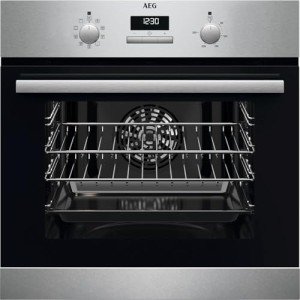
Oven For Kitchen
關注總覽
-
工作分類 批發/零售/傳直銷業
-
已發佈的工作 0
公司描述
You’ll Never Guess This Single Fan Oven’s Tricks
Understanding Single Fan Ovens: A Comprehensive Guide
Introduction
As contemporary kitchen areas grow significantly advanced, devices developed for efficiency and efficiency are at the forefront of customer interest. One such home appliance that stays popular amongst home cooks and baking lovers is the single fan oven, an electric design known for its versatility and ease of usage. This post provides in-depth info about single fan ovens, including their functionality, benefits, types, and factors to consider for purchase.
What is a Single Fan Oven?
A single fan oven, also known as a stove, features a single cooking chamber with a fan and exhaust system that distributes hot air consistently throughout the cooking area. This results in an even cooking temperature level and improved cooking performance compared to traditional static ovens.

Key Components of a Single Fan Oven
- Heating Elements: Usually situated on top and bottom, these create heat for cooking.
- Fan: The main feature that distributes the hot air within the oven, promoting much faster and more even cooking.
- Thermostat: Regulates the temperature to make sure optimal cooking conditions.
- Control Panel: Provides user interface alternatives for setting temperature levels, cooking times, and modes.
How Does a Single Fan Oven Work?
Single fan ovens run by integrating the heat from the heating aspects with the air movement produced by the fan. The hot air is distributed equally around the food, considerably reducing cooking time while likewise permitting lower cooking temperature levels.
Benefits of Using a Single Fan Oven
- Faster Cooking Times: The circulating air permits food to cook faster compared to conventional ovens.
- Even Cooking: Food is exposed to constant heat from all sides, reducing the chances of uneven cooking or locations.
- Versatility: These ovens can be utilized for baking, roasting, and even grilling, making them suitable for a large range of dishes.
- Energy Efficiency: By cooking at lower temperatures and in less time, these ovens might utilize less energy than their conventional counterparts.
- Wetness Retention: The style helps retain wetness in meals, resulting in juicy roasts and baked items with a light texture.
Types of Single Fan Ovens
When considering a single fan oven, consumers may come across different types based on features and style. Here are a few typical types:
1. Built-in Single Fan Ovens
- Description: Integrated into kitchen cabinetry for a smooth look.
- Pros: Saves counter space, aesthetically pleasing.
- Cons: Higher setup costs, might require expert help.
2. Freestanding Single Fan Ovens
- Description: Standalone systems that can be positioned anywhere in the kitchen.
- Pros: Easy to set up, versatile positioning.
- Cons: Can use up more area, may not blend well with kitchen cabinetry.
3. Range Cookers with Fan Ovens
- Description: Multiple cooking alternatives, consisting of a fan oven, combined in one system.
- Pros: Offers different cooking approaches, suitable for enthusiastic cooks.
- Cons: Generally more expensive, bigger footprint.
Comparison Table of Single Fan Oven Types
| Type | Pros | Cons |
|---|---|---|
| Built-in | Space-saving, aesthetically pleasing | Greater expenses, professional setup needed |
| Freestanding | Flexible positioning | Takes up more area, might not match cabinetry |
| Range Cooker | Several cooking approaches | Higher price, larger size |
Picking the Right Single Fan Oven
When picking a single fan oven, numerous elements should be considered to guarantee that it fulfills personal cooking requirements and fits within your kitchen design.
Factors to Consider
- Size and Capacity: The size ought to match your kitchen layout while offering enough capacity for your cooking routines.
- Functions and Functions: Look for adjustable racks, self-cleaning options, and numerous cooking modes to improve versatility.
- Energy Efficiency: Check for energy ratings; some designs are created to be especially energy-efficient.
- Budget: Costs can vary considerably, making it crucial to establish a reasonable budget ahead of time.
Upkeep Tips for Single Fan Ovens
- Regular Cleaning: Wipe down interior surface areas after use to avoid residue build-up.
- Inspect the Fan: Ensure the fan is complimentary from obstructions and working correctly.
- Inspect Seals: Regularly inspect the door seals for wear and tear to preserve cooking effectiveness.
- Expert Servicing: Schedule routine expert checks to guarantee optimum operation.
FAQs about Single Fan Ovens
1. Can I use my single fan oven for baking?
Definitely! Single fan ovens are exceptional for baking, offering constant temperatures vital for cakes, cookies, and breads.
2. Is it required to preheat a single fan oven?
While pre-heating is usually suggested for ideal results, due to the effectiveness of a fan oven, some recipes may not need it.
3. Can I cook numerous meals at the same time?
Yes! The even heat distribution in single fan ovens allows you to bake or roast numerous dishes at the same time, using all rack levels efficiently.

4. Does a single fan oven cook faster than a standard oven?
Yes, the fan-assisted heating lowers cooking times, making it possible for faster food preparation.
Single fan ovens offer a remarkable balance of speed, adaptability, and efficiency, making them a valuable addition to any kitchen. Whether for baking, roasting, or daily cooking, these ovens make sure that home cooks can produce scrumptious meals with ease. By understanding the benefits, types, and factors to consider for buying a single fan oven, customers can make an educated choice that lines up with their culinary desires and kitchen dynamics.
Accepting the functionalities of a single fan oven certainly paves the way for enhanced cooking experiences in the modern kitchen.
